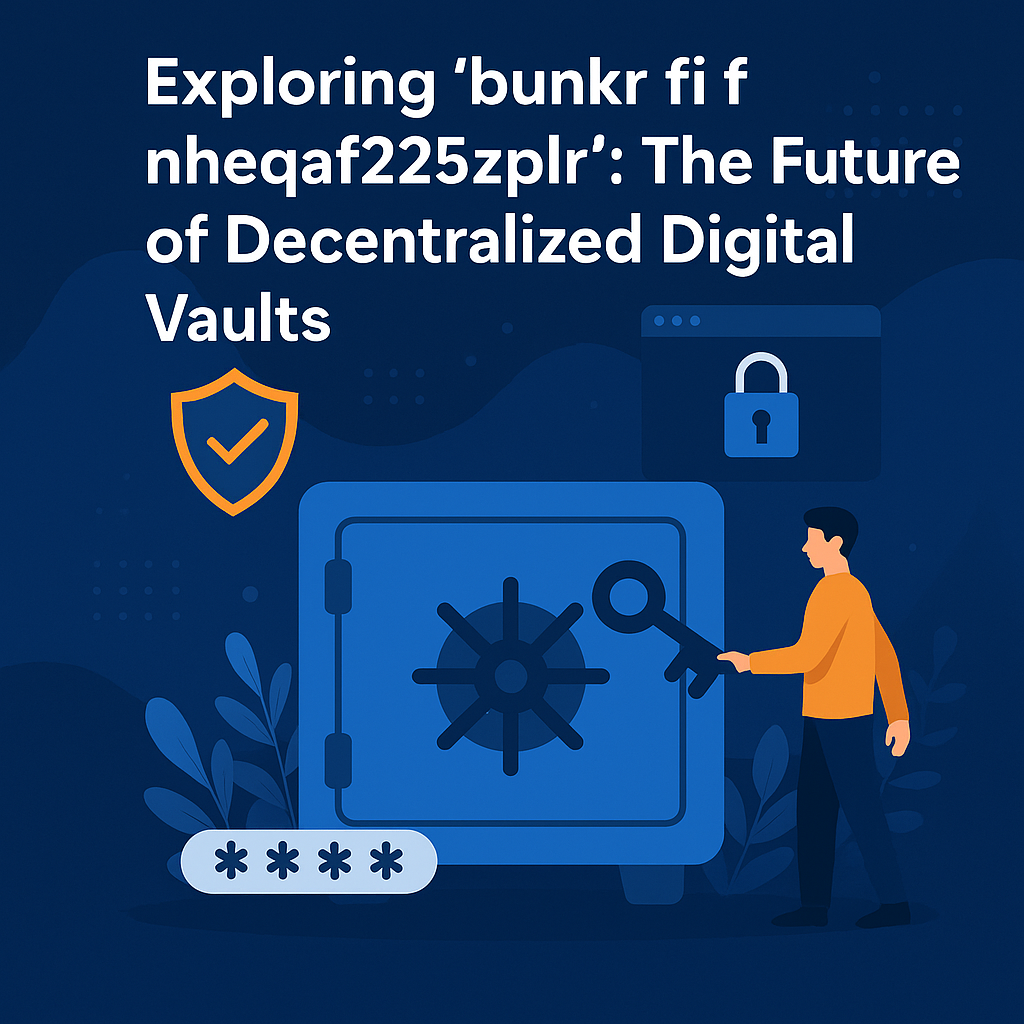Exploring “bunkr fi f nheqaf2r5zplr”: The Future of Decentralized Digital Vaults
In a rapidly evolving digital landscape, security, privacy, and control over one’s data have become essential rather than optional. The buzz around decentralized technologies, blockchain solutions, and encrypted data vaults continues to grow. Among the rising innovations in this sphere is an unusual yet increasingly referenced term: “bunkr fi f nheqaf2r5zplr”. While the name may sound cryptic, it represents a concept that might very well shape the future of how we manage digital assets.
What Is “bunkr fi f nheqaf2r5zplr”?
At first glance, “bunkr fi f nheqaf2r5zplr” might seem like a random string of characters, but to the initiated, it’s a code representing a secure digital vault or private bunker for critical files, digital assets, or even identities. The term breaks down into parts: “bunkr” refers to a storage bunker—suggesting safety and protection. “fi f” possibly represents a functional identifier for file integrity, and “nheqaf2r5zplr” is a unique alphanumeric code likely tied to encryption or access credentials.
This terminology is becoming symbolic in tech forums, underground data security communities, and even in some enterprise settings for denoting personalized, encrypted data repositories.
The Need for Secure Digital Vaults
We live in an era where cyber threats have outpaced traditional defenses. Centralized systems, though still prevalent, have proven vulnerable to hacks, data leaks, insider threats, and state-level surveillance. In 2024 alone, cybercrime led to losses exceeding $12 billion globally—much of it due to weak access control and poor encryption standards.
The growing emphasis on data ownership, user control, and privacy-centric solutions has led to a shift toward decentralized storage systems. That’s where terms like bunkr fi f nheqaf2r5zplr enter the discussion—as symbols of trustless, permissionless, yet highly secure storage solutions.
Key Characteristics of “bunkr fi f nheqaf2r5zplr” Systems
Advanced Encryption Protocols
At the heart of every “bunkr” system lies AES-256-bit encryption or higher. This ensures that even if someone gains physical access to the server or data unit, they cannot read the information without the decryption key—typically stored separately or split among multiple users (a process known as secret sharing).
Unique Identifier: nheqaf2r5zplr
The string “nheqaf2r5zplr” isn’t just for show. In most implementations, it acts as an encrypted access signature, verification token, or blockchain-based asset reference. These identifiers are generated using cryptographic hash functions and can’t be duplicated or forged, adding another layer of security.
Decentralized Architecture
Traditional storage providers like Google Drive or Dropbox operate on centralized models. “bunkr fi f nheqaf2r5zplr” is often used to reference decentralized file systems like IPFS (InterPlanetary File System) or Storj, which distribute data across nodes worldwide. This means your files are not sitting in one vulnerable server but are instead fragmented and replicated across multiple nodes—making data loss or unauthorized access far less likely.
Zero-Knowledge Access Control
Zero-knowledge proofs (ZKPs) are a rising trend in cryptography where one party can prove to another that something is true without revealing any actual information. Systems like “bunkr fi f nheqaf2r5zplr” often utilize ZKPs to authenticate users without needing to expose passwords, biometric data, or traditional keys.
Real-World Applications of “bunkr fi f nheqaf2r5zplr”
The strength and structure of these bunkr systems make them ideal for a wide range of use cases across industries and communities.
Whistleblower Platforms
For journalists or whistleblowers operating under oppressive regimes, secure communication and storage are critical. A system based on the bunkr fi f nheqaf2r5zplr architecture allows individuals to upload sensitive documents anonymously, safely, and with no retraceable digital fingerprint.
Cryptocurrency Key Storage
Losing private keys to crypto wallets can mean the loss of millions. That’s why decentralized vaults, especially those with integrated verification strings like “nheqaf2r5zplr,” are growing in popularity among serious crypto holders. These bunkrs store the keys in encrypted silos, ensuring both availability and confidentiality.
Medical Records
In the healthcare sector, patient data privacy is paramount. Decentralized, encrypted vaults can store complete medical histories, diagnostics, and prescriptions—accessible only to verified doctors or institutions via predefined identity hashes.
Personal Data Archiving
For privacy-conscious individuals, keeping personal files like legal documents, passports, academic certificates, or even journals in a secure, immutable system is incredibly appealing. With “bunkr fi f nheqaf2r5zplr,” users can maintain sovereignty over their information.
The Philosophy Behind the Bunkr Movement
Beyond the technicalities, there’s a philosophy driving the adoption of such systems. It is rooted in digital minimalism, freedom of information, and anti-censorship values. As more people become wary of Big Tech, surveillance capitalism, and data commodification, the need for truly autonomous digital environments becomes clear.
The “bunkr fi f nheqaf2r5zplr” concept champions:
-
User Ownership: You are the sole owner of your data. Not a corporation.
-
Selective Transparency: Share data only when and how you choose.
-
Permanence: Decentralized systems like IPFS ensure data is immutable and can’t be secretly deleted or modified.
Challenges and Considerations
While promising, bunkr-type systems are not without their challenges.
Complexity for Average Users
Setting up a secure digital vault using encryption, decentralized nodes, and access hashes can be daunting for the average user. Simplifying UI/UX without compromising security remains a work in progress.
Regulatory Uncertainty
Governments are still adapting their legal frameworks to address decentralized technologies. Storing sensitive data in such systems may conflict with local data residency or compliance laws.
Data Retrieval and Redundancy
In a fully decentralized system, if you lose access to your credentials or private keys, data retrieval can be impossible. Solutions like multi-signature backups or biometric verifications are being explored, but risks remain.
Future Outlook: Is “bunkr fi f nheqaf2r5zplr” the Beginning of a Larger Movement?
The term “bunkr fi f nheqaf2r5zplr” may be an obscure code today, but it is likely symbolic of a much larger transformation taking place across the digital world. With Web3, decentralized identity, and zero-trust architectures gaining ground, we may see widespread adoption of secure, customizable vault systems for both individuals and enterprises.
Startups, open-source communities, and even governments may eventually build interoperable frameworks using identifiers like “nheqaf2r5zplr” as global access tokens—transforming the way we store, share, and secure information forever.
Read also: Increase Online Sales by Garage2Global: Unlocking the Full Potential of Digital Commerce
Conclusion
“bunkr fi f nheqaf2r5zplr” may seem like a strange mix of characters, but it represents a powerful vision for the future of digital security—one where individuals reclaim control over their data through decentralization, encryption, and smart authentication.
Whether you’re a privacy advocate, a blockchain developer, or just someone tired of uploading personal files to corporate clouds, the bunkr approach offers a new path forward. As we continue navigating the threats and challenges of our digital lives, systems like this could become the standard rather than the exception.














Post Comment